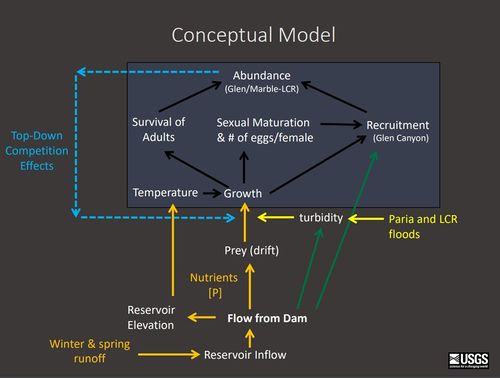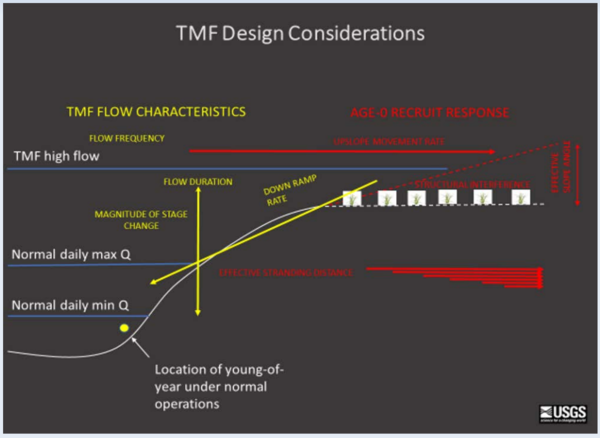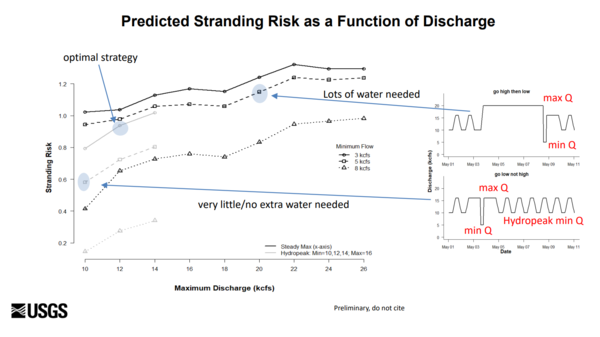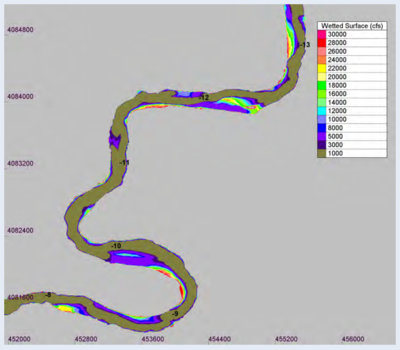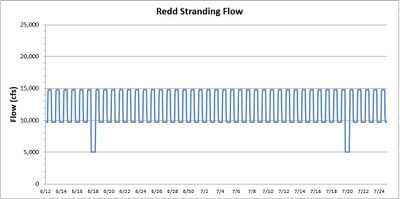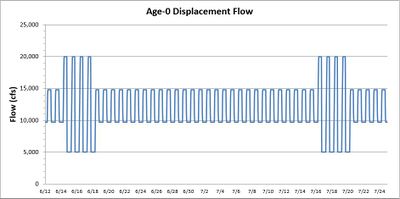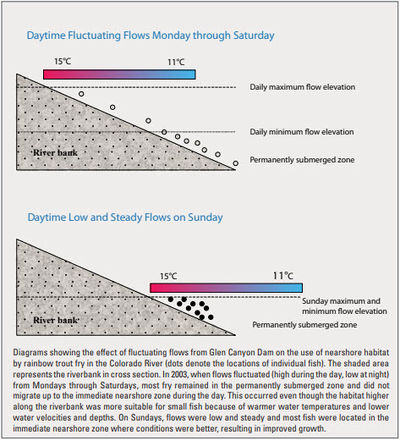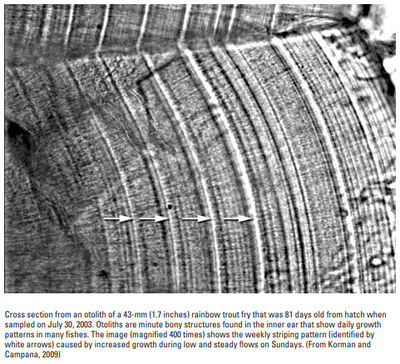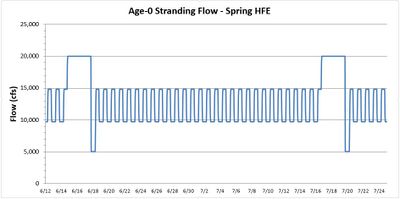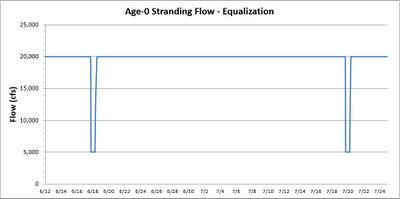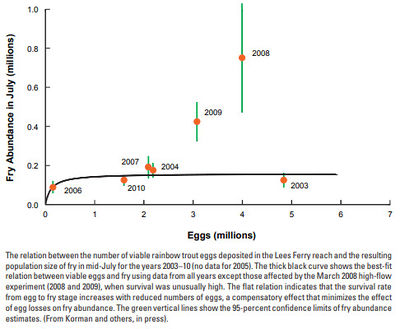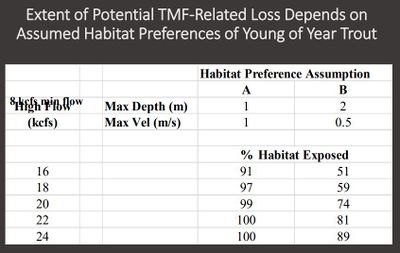Trout Management Flow (TMF) Uncertainties
|
- How high does the max flow (Q) need to be?
- Duration at the max flow and min flow?
- How fast does the down-ramp rate need to be?
- What kind of habitat induces more stranding? And what proportion of Glen Canyon comprises that habitat type?
- How many cycles of TMFs need to be implemented in one season?
- What is the overall population abundance response to TMFs?
- Will this work for Brown Trout? If so, what differences need to be considered? [2]
|
Predicted Wetted Area - Glen Canyon
|
|
Large areas exposed between 26-18 kcfs
- Stranding fry over this flow range requires sustained high flows of ~ 26 kcfs.
- Only feasible in equalization years (e.g. 2011)
Large areas exposed between 5-3 kcfs
- Dropping flows from normal daytime highs of ~ 16-18 kcfs to 3 kcfs is feasible given constraints on release volume
Majority of shoreline in Glen Canyon is steep
- TMFs have to occur when young fry (< 50 mm) are using low angle shorelines
- Not all young fry will be using habitats that are vulnerable to stranding
|
Possible Trout Management Flow (TMF) Treatments
|
Treatment 1: Redd stranding flows (with mechanical removal of redds below the minimum flow elevation)
This treatment uses flow manipulation at Glen Canyon Dam to periodically dewater redds (nests trout build to lay their eggs in) during the rainbow trout spawning period thereby reducing the number of viable eggs that could hatch and recruit to the age-0 trout population. The objective of this treatment would be to dewater and/or mechanically remove between 50% and 90% of the redds produced over the spawning season. This is one of the mechanisms that is thought to have limited age-0 trout recruitment under pre-ROD conditions.
Redd stranding flows could be implemented within current ROD guidelines and would consist of a period of high steady flows for an extended period of time to encourage fish to spawn on higher elevation gravel bars and benches
during the peak spawning period (February-April). Flows would then be reduced to the lowest allowable minimum flow for a dewatering treatment lasting 10-12 hours and occurring every 2-4 weeks over the incubation period
(mid-March to mid-May). This treatment should occur during the daytime to take advantage of heating the spawning gravels, which is more effective at reducing the survival of eggs and alevins (newly hatched trout) than just
dewatering them. Redds below the minimum flow elevation could be mechanically treated using a hydraulic pressure washer in shallow water or a suction dredge in deeper water to increase the effectiveness of this treatment.
Mechanical removal of redds would be less labor intensive than mechanical removal of age-0 fish.
This treatment would likely be most effective during periods of extended high flows (i.e. equalization flows) due to the tendency of trout to spawn higher on gravel bars under these flow conditions. The effectiveness of this treatment is limited by how low flows could be reduced without impacting other resources in the canyon, such as aquatic foodbase resources used by adult rainbow trout. The effectiveness of this treatment is also limited by compensatory mechanisms where increased survival of young trout may increase under low density conditions. An initial test of this treatment from 2003-2005 resulted in strong compensatory survival of fry produced from redds located below the minimum flow level and resulted in no observable reduction in the number of age-0 trout later in the year.
- Attempted in January-March 2003-2005
- Killed between 25-50% of eggs
- Deemed ineffective because the number of fry produced was similar to years with normal operations (compensatory survival) [3]
Treatment 2: Age-0 Trout Displacement Flows
This treatment relies on increased daily flow fluctuations to reduce the habitat availability of age-0 trout (fry and juveniles). This would make age-0 trout more reliant on sub-optimal habitats where they would be subject
to poorer growing conditions. Daily flow fluctuations have been shown to negatively impact age-0 trout without affecting larger trout (Makinster et al. 2011). Under this flow regime age-0 trout are more likely to remain in
deeper, colder water with higher velocities. This should result in decreased growth rates and lower survival. Habitat limiting flows could be enhanced by increasing the allowable daily fluctuation when age-0 trout are most
sensitive to flow fluctuations (May-August). A nighttime minimum flow treatment would be more effective than a daytime treatment because age-0 trout typically come closer into shore at night. Increasing limits on daily
fluctuations beyond ROD limits on at least a weekly basis would likely increase the effectiveness of this treatment. A critical component of this treatment would be to ensure that flows drop to the lowest allowable minimum flow for 12-14 hours on at least a weekly basis to dewater shallow gravel bars and benches in the Lees Ferry reach. Fluctuating flows like these are another mechanism that is thought to have limited age-0 trout recruitment under pre-ROD conditions.
This treatment would likely be most effective during periods of time when releases from Glen Canyon Dam are already fluctuating for power generation. This treatment may be more effective at having a population level response than redd stranding flows because it is targeting an older age class that is less likely exhibit a density-dependent response.
- Suppression flow window: May-August [4]
- Age-0 trout generally do not adjust position to stay in shallow water as flows come up (restricted movement) [5]
Treatment 3: Age-0 Trout Stranding Flows
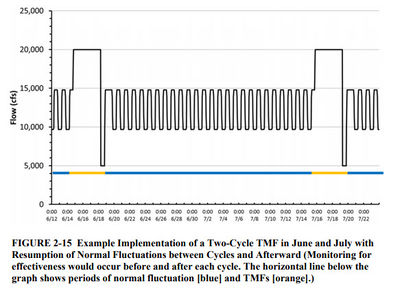 Example of a possible TMF illustrated in the LTEMP FEIS This treatment relies on a period of high steady flows to draw age-0 trout (fry and juveniles) onto high elevation gravel bars and benches and then stranding those fish by rapidly decreasing releases from Glen Canyon Dam. Age-0 trout stranding flows could be provided within ROD guidelines with the treatment consisting of a period of high steady flows for an extended period of time to encourage age-0 trout to inhabit high elevation gravel bars and benches. Flows would then be rapidly reduced to the lowest allowable minimum flow for a dewatering treatment lasting 10-12 hours and occurring every 2-4 weeks. This treatment would take place from May to August when age-0 trout are most likely to be in these near-shore habitats. A nighttime minimum flow treatment may be more effective than a daytime treatment because age-0 trout typically come closer into shore at night. Increasing downramp rates and reducing flows below ROD guidelines may make this treatment more effective. The ROD currently limits downramp rates to 2,500 cfs/hr to reduce the probability of stranding young fish in nearshore habitats. Operationally, down ramping from 33,200 cfs (maximum power plant capacity at Glen Canyon Dam) to the daily minimum could occur nearly instantaneously.
This treatment would be most effective during periods of extended high flows (i.e. equalization flows) due to the likelihood of age-0 fish of utilizing high elevation gravel bars and benches when flows are held high and
steady for an expanded period of time. As with Treatment 2, this treatment may be more effective at having a population level response than redd stranding flows because it is targeting an older age class that is less
likely to exhibit a density-dependent response. This treatment, however, may also strand larger, more desirable trout occupying nearshore habitat during the night as well. Any larger fish caught in the nearshore during a
stranding event would likely be more susceptible to mortality than smaller, age-0 fish because they would not be able to escape or endure the stranding as readily as a smaller fish.
Treatment 4: Increase or Maintain Turbidity in Marble Canyon during Periods of High Trout Recruitment
This treatment is founded on observations from the Natal Origins project which indicate that the number of rainbow trout at the LCR can be reduced by limiting the frequency of fall HFEs when trout abundance in Marble Canyon is high. The Natal Origins project found that one of the factors affecting rainbow trout abundance in Marble Canyon is a trout’s ability to maintain a positive condition factor by efficiently finding and consuming food. Because rainbow trout are sight feeders and eat macroinvertebrates drifting in the water column, feeding efficiency can be substantially reduced by a relatively small increase in turbidity. The Natal Origins projects found that rainbow trout in Marble Canyon typically only grow in the winter and spring because turbidity in the summer and fall is too high for them to find food. Modeling has indicated that foregoing a fall HFE in a year with a large sediment input from the Paria River allows enough fine sediment to remain in Marble Canyon to provide a small increase in turbidity (from ~5 NTU to ~35 NTU) over the subsequent winter. The model also predicts this small increase in turbidity reduces the maximum reactive distance of rainbow trout by 20-30% when compared to conditions if a fall HFE was implemented. Modeling indicates that a reduction in reactive distance of this magnitude is sufficient to reduce condition factor enough to limit reproduction and abundance of rainbow trout below the Paria River. [6]
This treatment would be most effective during periods of high trout abundance in Marble Canyon and large sediment inputs from the Paria. This treatment could also be considered immediately following a large
recruitment event of rainbow trout in the Lees Ferry reach since data from the Natal Origins project suggests that immigration to Marble Canyon increases under these conditions.
Increasing turbidity in Marble Canyon to the levels discussed here would likely not impact humpback chub and other native fish since they evolved in a turbid river environment. This treatment has the potential to be able to reduce the Program’s reliance on mechanical removal and other more lethal and expensive approaches to TMFs that some groups (i.e. Tribes, anglers, power users, etc.) find objectionable. Increased turbidity may also reduce direct predation pressure on native fish by nonnative fish like rainbow trout. Predation by other nonnative fish, like brown trout, appear not to be affected by the levels of turbidity being discussed here. Reducing the number of fall HFEs would have a negative impact to sediment-related resources unless the sediment accounting periods in the HFE protocol could be adjusted to allow for fall sediment from the Paria be used for a spring HFE, of which a number of resources would benefit including foodbase, the trout fishery, and recreational beach use.
|
Possible TMF Treatment Scenarios
|
|
Differences in the efficiency of Trout Management Flows suggest that each of the three treatments discussed above may be more effective under some flow scenarios than others. For example, redd stranding flow and age-0 trout stranding flows would likely be more effective when releases can be held high and steady for an extended period of time (i.e. spring HFEs and equalization flows) whereas age-0 trout habitat limiting flows would likely be more effective at lower flows more typical of normal operations. Releases from Glen Canyon Dam could also be manipulated for short periods of time to where the three treatments outlined above could be used sequentially to target different vulnerabilities of age-0 trout as they age over the course of the year. Several scenarios are presented below for how Trout Management Flows could be incorporated into various release schedules for a range of operations.
Scenario 1: Normal Operations
This scenario describes a combination of possible Trout Management Flows that could be implemented during normal operations. First, conduct a pre-treatment redd counts in February and March to get an estimate of trout production. Once every 2-4 weeks beginning in mid-March, reduce releases early in the morning to the lowest allowable minimum flow and hold for 10-12 hours. Remove redds located below the minimum flow elevation with a hydraulic pressure washer or a suction dredge when the water levels are low (Treatment 1). Repeat every 2-4 weeks until May. Beginning in May, proceed with age-0 trout displacement flows (Treatment 2) by increasing daily flow fluctuations to as high of level as allowable. Continue with these high flow fluctuations until the end of August. During the first week of September, perform a population estimate on the age-0 trout population to determine the effectiveness of this actions.
- Large fluctuations in daily flows are thought to have limited egg survival and age-0 trout recruitment under pre-ROD conditions.
Scenario 2: Monitoring detects an increasing abundance of rainbow trout in Marble Canyon
This scenario describes a situation where monitoring detects an increasing abundance of rainbow trout in Marble Canyon to the point where mechanical removal may be triggered. This scenario may also apply to a situation where an operation like a spring HFE or equalization creates a large rainbow trout recruitment event and young rainbow trout are expected to immigrate into Marble Canyon. In either case, a sediment-triggered fall HFE would be canceled and the sediment input would be allowed to dissipate over the winter thereby increasing turbidity levels below the Paria and disadvantaging rainbow trout that have immigrated into Marble Canyon. This would continue until the abundance of rainbow trout in Marble Canyon returns to acceptable levels.
Scenario 3. Spring HFE
This scenario describes a combination of possible Trout Management Flows that could be implemented during a spring HFE. Conduct a pre-treatment redd count in February and March to get an estimate of trout production. Once every 2-4 weeks beginning in mid-March, reduce releases early in the morning to the lowest allowable minimum release and hold for 10-12 hours to dewater redds. During the day of the treatment when the water levels are low, remove redds located below the minimum flow elevation with a hydraulic pressure washer or a suction dredge (Treatment 1). Repeat every 2-4 weeks until the end of April. Implement the spring HFE at the end of April. At the conclusion of the spring HFE, downramp flows as fast as allowable to the lowest allowable minimum flow for a nighttime stranding treatment lasting 10-12 hours (Treatment 3). Then proceed with age-0 trout displacement flow treatments by increasing daily flow fluctuations to as high of level as allowable (Treatment 2). Continue with these high flow fluctuations until the end of August. During the first week of September, perform a population estimate on the age-0 trout population to determine the effectiveness of this actions.
- Run Spring HFE as late in the window as possible (lower survival before the HFE than after [7])
- Survival rates of YOY trout increased 4x following the March 2008 HFE [8]
Scenario 4. Equalization flows that require full power plant releases for an extended period of time
This scenario describes a combination of possible Trout Management Flows that could be implemented during equalization flows. Conduct a pre-treatment redd count in February and March to get an estimate of trout production. Once every 2-4 weeks beginning in mid-March, reduce releases early in the morning to the lowest allowable minimum release and hold for 10-12 hours to dewater redds. During the day of the treatment when the water levels are low, remove redds located below the minimum flow elevation with a hydraulic pressure washer or a suction dredge (Treatment 1). Repeat every 2-4 weeks until the end of April. Beginning in May, downramp flows one day every 2-4 weeks as fast as allowable to the lowest allowable minimum flow for a nighttime stranding treatment lasting 10-12 hours (Treatment 3). Repeat every 2-4 weeks until the end of the equalization flow (probably September 30). During the first week of October, perform a population estimate on the age-0 trout population to determine the effectiveness of these actions.
- The 2012 equalization flow increased survival of YOY trout ultimately leading to an over population of trout in the ferry and a subsequent population crash during the winter of 2014-15. [9]
|
|
Links
|
|
|
Possible mechanisms that might control trout reproduction
|
- Stranding
- Displacement into suboptimal habitats
- Increasing turbidity (makes it harder for trout to find food)
- Mechanical removal (angling, electrofishing, etc.)
- Manipulating food supplies (Bugflows, spring release, nutrients, etc.)
|
|
|
Treatment 1: Redd stranding flows
Treatment 2: Age-0 Trout Displacement Flows
- Optimal fluctuation range
- Optimal ramp rates
- Timing and duration
Treatment 3: Age-0 Trout Stranding Flows
- Duration of high flows needed to lure YOY rainbow trout into near-shore habitats
- Magnitude of the high flow that would be more effective in luring YOY trout to near-shore habitats
- Whether or not moving to high flows first is needed to reduce YOY trout numbers (as opposed to simply dropping rapidly from normal flows to minimum flows)
- Timing of TMF cycles during the May–August period of trout emergence
- Number of cycles necessary to effectively limit trout recruitment
- Can an action like this overcome density-dependent mortality? [10]
Treatment 4: Increase or Maintain Turbidity in Marble Canyon
- Improve calibration of shifting rating curve sediment transport model (Wright).
- Quantify effect of turbidity on drift in Marble Canyon.
- Current estimate of trout growth reduction without HFEs is likely too low because it assumes higher turbidity does not reduce invertebrate biomass (Yackulic/Deemer/Kennedy).
- Model net effect of reduced trout abundance and higher turbidity on Humpback Chub at the LCR (Dzul/Yackulic).
- Need to improve trout monitoring in Marble Canyon if managers decide to use trout abundance as one of the HFE triggers [11]
|
Susceptibility timing of trout to TMFs
|
Rainbow trout
- Peak spawn in March-April
- Peak emergence in May-June
- Young rainbow trout most vulnerable to flow changes shortly after emergence = May-July*
Young of year trout are likely most vulnerable to stranding May-June. Efficacy of TMFs in July and August are uncertain. [12]
Brown trout
- Peak spawn in October to December [13]
- Peak emergence in February to April
- Young brown trout most vulnerable to flow changes shortly after emergence = February to April
|
Other Resources that may be affected
|
- Hydropower: reduction in value and capacity
- Foodbase: reduction in production, drift, and food availability
- Native fish: increase in stranding
- Tribal sensitivities: concerns of intentionally killing fish and sanctity of life
- Lees Ferry fishery: concerns of intentionally killing a sport fish, perceptions that the sport fishery is being suppressed and associated reduction in people coming to fish
- Boater safety: reduced access to the Lees Ferry reach and difficulty in navigating rapids in Grand Canyon due to low flows, increased variation from normal operations and having to track flows
- Recreation: increased sediment transport and beach erosion
|
LTEMP descriptions of a TMF
|
Characteristics of a TMF
- Repeated fluctuation cycles that consist of relatively high flows
- Up-ramp rates: 4,000 cfs/hr
- High flows are sustained for a period of time
- Followed by a rapid drop to a very low flow, down-ramp from peak to base would be over a single hour
- Low flow would be maintained for a period of less than a day and would be timed to start in the morning, after sunrise
- Can be implemented from May through August
Testing
- First tests could be triggered by modeled trout recruitment levels or otherwise implemented to test the effectiveness of TMFs
- Tests would start with a conservative application of two cycles in June and July, but could be increased based on experimental testing to as many as three cycles per month for 3 months (May, June, and July)
- TMFs would be tested two to three times in the early part of the LTEMP period while attempting to minimize confounding effects with other experimental treatments
- If TMFs are determined to be effective while minimizing impacts on other resources, they may be deployed on a regular or triggered basis by estimated trout recruitment
- Effectiveness would be judged based on comparison of fall trout recruitment estimates to expectations based on prior years
- Due to concerns regarding the risk associated with implementation of spring HFEs and a related trout response and subsequent effects on the humpback chub population, TMFs would be implemented and tested for effectiveness as early in the LTEMP period as possible, preferably before the first spring HFEs are triggered, even if not triggered by high trout recruitment.
Triggers
- For the EIS modeling, a trigger of 200,000 YOY trout was used to determine when TMFs would be implemented
- The LTEMP trigger was based on a regression equation involving annual volume, the variability in flows from May through August, and the occurrence of a spring HFE yielding a predicted number of YOY rainbow trout.
- The actual trigger used could be higher or lower depending on the results of experiments that will be conducted on the effectiveness of TMFs.
- The predictive regression equation could be modified based on new information.
- Triggers for implementation of TMFs would also be developed in consultation with the AZGFD and other entities as appropriate.
- Monitoring of other resources, particularly food base and the physiologic condition of adult rainbow trout, would also be considered.
- The number of YOY trout at the end of the summer would be estimated to determine if it equals or exceeds the estimated number of recruits needed to sustain the desired number of adult trout. If the estimated number of recruits is less than the recruitment target, TMFs would be re-evaluated for modification before implementation in subsequent years.
- If there is an observed increase in trout recruitment due to fall HFEs, then application of TMFs in the spring following a fall HFE would be considered.
Implementation
- TMFs could be implemented in years that feature a spring HFE and in the water year that follows an equalization flow because of the expected positive effects of equalization on rainbow trout recruitment.
- Any implementation of TMFs would consider the status of the trout fishery prior to implementation.
- Modeling indicates TMFs would be triggered by trout recruitment numbers in 32% of the years in the LTEMP period.
- Timing of TMFs may also be adjusted based on the best scientific information available related to trout emigration behavior.
|
Presentations and Papers
|
|
2022
2020
2019
2018
2017
2016
- Yard, M.D., Korman, J., Walters, C.J., and T.A. Kennedy. 2016. Seasonal and spatial patterns of growth of rainbow trout in the Colorado River in Grand Canyon Arizona. Can. J. Fish. Aquat. Sci. 73:125-139.
- Korman, J, Yard, M.D., and C.B. Yackulic. 2016. Factors controlling the abundance of rainbow trout in the Colorado River in Grand Canyon in a reach utilized by endangered humpback chub. Can. J. Fish. Aquat. Sci. 73:105-124.
- Lees Ferry Recreational Trout Fishery Management Recommendations: The Voice of Lees Ferry Recreational Anglers, Guides, and Businesses
2015
2013
2012
2011
2010
2009
2005
1995
|
|
|
|
Recommendation #5.
Under certain conditions, rainbow trout at Lees Ferry have reproduced prolifically. Historically, when
there is an over-abundance of young-of-year rainbow trout, the quality and condition of rainbow trout decline.
This is likely due to the low quality and low abundance of food sources in Lees Ferry. Trout Management Flows
(TMFs) are flow treatments that are hypothesized to reduce the abundance of young-of-year trout by stranding
trout shortly after they emerge from their redds (Korman, Ecometric Research, Inc., personal communications, 2015).
We believe the best long term and ecologically appropriate solution to controlling trout densities is
to increase invertebrate diversity and manage Grand Canyon Dam flows to avoid excessive trout spawning
and recruitment (see recommendations related to the aquatic food base and equalization flows). We are concerned about the
collateral damage that TMFs could have on other resources especially the aquatic food base and native
fish. TMFs may be especially useful when spring HFE's are implemented or in years when high equalization flows are required.
TMF's should only be implemented in a carefully designed experimental framework that includes quantified
criteria for success (for managing trout recruitment and improving the humpback chub population) and the
impacts to other resources, especially the aquatic food base, are fully assessed. TMF's should only be used when the
rainbow trout population is stable and includes a healthy abundance of all size classes of rainbow trout.
Mitigation measures such as emergency stocking of trout need to be in place prior to the implementation of TMFs in case of
catastrophic loss to the fishery (see recommendations on Trout Stocking). In conclusion, the experimental
evaluation of TMFs needs to recognize the trout fishery as a highly valued asset. The AZGFD should have a seat at the
table along with Federal agencies on any discussion and decisions related to implementation of TMFs.
|
Descriptions of Trout Management Flows in LTEMP
|
|
TMFs are a special type of fluctuating flow designed to reduce the recruitment of trout by
disadvantaging YOY trout (Figure 2-15). TMFs have been proposed and developed on the basis
of research described in Korman et al. (2005). The underlying premise of TMFs is based on
observations that YOY trout tend to occupy near-shore shallow-water habitats to avoid predation
by larger fish. TMFs feature repeated fluctuation cycles that consist of relatively high flows
(e.g., 20,000 cfs) sustained for a period of time (potentially ranging from 2 days to 1 week)
followed by a rapid drop to a very low flow (e.g., 5,000 cfs to 8,000 cfs). This low flow would
be maintained for a period of less than a day (e.g., 12 hr) to prevent adverse effects on the food
base. Low flows would be timed to start in the morning, after sunrise, to expose stranded fish to
direct sunlight and heat. Up-ramp rates to the TMF would be the same as the limit for this
alternative overall (i.e., 4,000 cfs/hr). The down-ramp from peak to base would be over a single
hour (e.g., 15,000 cfs/hr for a drop from 20,000 cfs to 5,000 cfs). In a TMF flow cycle, YOY
trout are expected to occupy near-shore habitat when flows are highest, and would be stranded
by the sudden drop to low flow. Because older age classes of trout tend to occupy deeper habitats
toward the middle of the river channel, they are less susceptible to stranding and are less likely to
be directly affected by TMFs. TMFs would be used to control trout recruitment in the Glen
Canyon reach to manage the rainbow trout fishery, and to limit emigration of juvenile trout to
downstream reaches, particularly to habitat occupied by humpback chub near the confluence
with the Little Colorado River. Triggers for implementation of TMFs would be determined in
consultation with the AZGFD.
It should be noted that several Tribes have expressed concerns about TMFs as a taking of
life within the canyon without a beneficial use. The Pueblo of Zuni has expressed concern that
the taking of life by trout stranding has an adverse effect on the Zuni value system. The joint-lead
agencies will continue to work with the Tribes regarding options for trout management.
TMFs may be tested under this alternative early in the LTEMP period, even if not
triggered by high trout recruitment. The intent of these early tests would be to determine the
effectiveness of TMFs in reducing trout recruitment and the emigration of young trout to Marble
Canyon and the Little Colorado River reach. The condition of the trout fishery, as determined in
consultation with AZGFD, and potential impacts on other important resources would be
considered prior to implementing TMFs. If TMFs are determined to be effective for these goals
while minimizing impacts on other resources, they may be deployed on a regular or triggered
basis. TMFs would be tested two to three times in the early part of the LTEMP period while
attempting to minimize confounding effects with other experimental treatments. Tests would
start with a conservative application of two cycles in June and July (Figure 2-15), but could be
increased based on experimental testing to as many as three cycles per month for 3 months (May,
June, and July).
TMFs (described in Section 2.2.3.2) are a potential tool that could be used to control
annual trout production in the Glen Canyon reach for purposes of managing the trout fishery and
for limiting emigration from the Glen Canyon reach to Marble Canyon and the Little Colorado
River reach. If resource conditions are appropriate, TMFs may be tested under Alternative D
early in the experimental period, preferably in the first 5 years. These first tests could be
triggered by modeled trout recruitment levels or otherwise implemented to test the effectiveness
of TMFs. The intent of these early tests would be to determine the effectiveness of TMFs and a
best approach to trout management. If TMFs are determined to be effective for controlling trout
numbers while minimizing impacts on other resources, they may be deployed as an adaptive
experimental treatment triggered by estimated trout recruitment.
It should be noted that several Tribes have expressed concerns about TMFs as a taking of
life within the canyon without a beneficial use. The Pueblo of Zuni has expressed concern that
the taking of life by trout stranding has an adverse effect on the Zuni value system. The joint-lead
agencies will continue to work with the Tribes regarding options for trout management, and
to determine the most appropriate means of mitigating impacts on Tribal values if TMFs are
implemented.
As many as three TMF cycles/month (see Section 2.2.3.2) in a period of up to 4 months
during May through August could be tested, depending on the results of early tests. Aspects of TMF design that would be investigated include:
- Duration of high flows needed to lure YOY rainbow trout into near-shore habitats,
- Magnitude of the high flow that would be more effective in luring YOY trout to near-shore habitats,
- Whether or not moving to high flows first is needed to reduce YOY trout numbers (as opposed to simply dropping rapidly from normal flows to minimum flows),
- Timing of TMF cycles during the May–August period of trout emergence, and
- Number of cycles necessary to effectively limit trout recruitment.
If TMFs prove to be effective in controlling trout production and emigration to the Little
Colorado River reach, and they become an integral part of the LTEMP, regular implementation
of TMFs may need to include variable timing to prevent adaptation of the population to specific
timing (e.g., increase in recruitment by fall-spawning rainbow trout).
Certain aspects of TMF effectiveness can be addressed through observational studies
(e.g., the number of YOY rainbow trout observed in the near-shore environment in daily
increments after the high flow is initiated); others may be addressed through consideration of
the physical environment in Glen Canyon (i.e., what areas are inundated or exposed at different
flows). Ultimately, however, effectiveness would be judged based on comparison of fall trout
recruitment estimates to expectations based on prior years. It may take several years to make this
determination, depending on the strength of the response and the type of TMFs tested.
Ultimately, however, effectiveness would be based on the ability of TMFs to reduce recruitment
in and emigration from the Glen Canyon reach. The driving forces behind emigration are not
fully understood, but are expected to be related to population size and food base in the Glen
Canyon reach.
For the EIS modeling, a trigger of 200,000 YOY trout was used to determine when TMFs
would be implemented. A regression equation based on annual volume, the variability in flows
from May through August, and the occurrence of a spring HFE was used to predict the number
of YOY. The actual trigger used could be higher or lower depending on the results of
experiments that will be conducted on the effectiveness of TMFs. In addition, the predictive
regression equation could be modified based on new information. The trigger and predictive
equation used would be modified as needed in an adaptive management context utilizing the
process described in Section 2.2.4.3. Triggers for implementation of TMFs would also be
developed in consultation with the AZGFD and other entities as appropriate.
Monitoring of other resources, particularly food base and the physiologic condition of
adult rainbow trout, would also be considered. In addition, the number of YOY trout at the end
of the summer would be estimated to determine if it equals or exceeds the estimated number of
recruits needed to sustain the desired number of adult trout. If the estimated number of recruits is
less than the recruitment target, TMFs would be re-evaluated for modification before
implementation in subsequent years. It is anticipated that the trout population could rebound
from a 1-year drop below this target level.
As discussed in relation to sediment experiments above, there is concern among scientists
and stakeholders with regard to the risk associated with implementation of spring HFEs as
related to trout response and subsequent effects on the humpback chub population. For this
reason, TMFs would be implemented and tested for effectiveness as early in the LTEMP period
as possible, preferably before the first spring HFEs are triggered, even if not triggered by high
trout recruitment. TMFs could be implemented in years that feature a spring HFE and in the
water year that follows an equalization flow because of the expected positive effects of
equalization on rainbow trout recruitment. Any implementation of TMFs would consider the
status of the trout fishery prior to implementation. Modeling indicates TMFs would be triggered
by trout recruitment numbers in 32% of the years in the LTEMP period.
There is potential for confounding effects when coupling TMFs with HFEs. If trout
recruitment is still high after implementation of TMFs that follow HFEs, this would suggest
TMFs were not effective as designed for that trial. If recruitment is lower than expected after
TMF implementation, however, uncertainty will remain about whether an HFE failed to
stimulate trout recruitment or whether TMFs were effective in suppressing otherwise strong
recruitment. It may not be necessary to determine the underlying effect on trout numbers unless
TMFs have undesirable side effects on other resources or the trout population.
If TMFs are found to be highly effective in controlling trout recruitment and emigration
of trout, and emigration only occurs or primarily occurs immediately following high recruitment
years, it may be possible to limit TMF implementation and achieve multiple resource goals,
particularly if unintended impacts of TMFs on other resources such as native fish become
evident. Timing of TMFs may also be adjusted based on the best scientific information available
related to trout emigration behavior. If adverse impacts of TMFs become evident, this may also
suggest revisiting whether or not TMFs are necessary in response to spring HFEs. Lastly, if,
there is an observed increase in trout recruitment due to fall HFEs, then application of TMFs in
the spring following a fall HFE would be considered.
Implementation of TMFs would consider resource condition assessments and resource
concerns using the processes described in Sections 2.2.4.3 and 2.2.4.4. TMFs may not be tested
when there appears to be the potential for unacceptable impacts on the resources listed in
Section 2.2.4.3.
Experimental Trout Management Flows (TMFs) could be used to control annual
rainbow trout production in the Glen Canyon reach for the purposes of managing
the rainbow trout fishery and for limiting emigration to Marble Canyon and the
Little Colorado River reach. TMFs would be tested early in the experimental
period, preferably in the first 5 years. Under the LTEMP EIS, TMFs could occur from May to August.
Biological Opinion, page 72
LTEMP includes implementation of ongoing and new conservation measures that are
designed to reduce the effects of the proposed action and improve the status of humpback
chub. Conservation measures identified in the 2011 BO on operations of Glen Canyon
Dam (USFWS 2011a) included the establishment of a humpback chub refuge, which has
been created and will continue to be funded as a part of this action. Other conservation
measures include humpback chub translocation; Bright Angel Creek brown trout control;
determination of the feasibility of flow options to control trout, including increasing daily down-ramp rates to strand or displace age-0 trout, and high flow followed by low flow to strand or displace age-0 trout; assessments of the effects of actions on humpback chub
populations; sediment research to determine effects of equalization flows; and Asian
tapeworm monitoring. Conservation measures that were not completed are ongoing and
are elements of existing management practices (e.g., brown trout control, humpback chub
translocation, and sediment research to determine the effects of equalization flows), while
new conservation measures or adjustments to the existing ones have been developed for
the proposed action. Many of these conservation measures meet management objectives
identified in the Humpback Chub Recovery Goals (USFWS 2002a), including
investigating the anticipated effects of and options for providing warmer water
temperatures in the mainstem Colorado River through Grand Canyon, ensuring adequate
protection from diseases and parasites, and the regulation and control of nonnative fish.
|
History of GCDAMP's Assement of "CRe Turbidity Managment" to Conserve Native Fish
|
- Spring 2002 – HBC “911” Emergency Response – fish biologists report declining trend in adult HBC, the finding results in AMWG’s humpback chub ad hoc committee and consideration of a dozen experimental “management strategies” intended to arrest the decline and conserve humpback chub - one of which is to determine feasibility of importing “fine-sediment” from Lake Powell source areas to the CRe, near the Paria River confluence w/ the Colorado River = turbidity cover for native fish when Paria does not contribute enough fines to meet a “200 FNU” condition in the main channel of Marble / Eastern Grand Canyons.
- 2004-5 – Mechanical Removal project reports abrupt decline in rainbow trout throughout Marble and Grand Canyons at start of Year-3 MR treatment, and this step-change (shown in Coggins et al, 2011, Fig 7, p. 468) coincides with long string of Paria and LCR floods / sediment inputs that occurred from mid-September 2004 through January 2005; including the largest winter Paria River flood in January 2005, since December 1966.
- 2007 – Sediment Augmentation - Randle et al. (2007) deliver final technical feasibility report to AMWG, which declares that sources of fine sediment from the delta of Navajo Creek within Lake Powell could, in fact, be transported around Glen Canyon Dam & delivered to the CRe to manage turbidity of Marble and eastern Grand Canyons, but at a cost ranging from $150 (silt/clay only) – 400 (silt/clay/sand) million w/ annual maintenance of ~$9 million if an extra 1 Tg of sand were also to be augmented for sandbars as well. (estimated costs provide a means to value Paria River sediment provided as “ecosystem service” compliments of Mother Nature.
- Fall 2010 – Non-Native Trout Control EA / SDM Workshop – fish experts identify 19 options for controlling trout below Lees Ferry, with concept of “turbidity curtain” being rated the most effective long-term strategy (see Runge et al., 2011, p. 29, Table 3, hybrid option E [Sediment curtain (single strategies: 3b, 5e, 6, 13): #13 is long-term strategy to emigration; #5 is the short-term strategy to emigration while infrastructure is being built; #3 is needed in short-term to reduce extant RBT population. Assumptions: RBT and BNT limit HBC recovery, Lees Ferry is the source of RBT, removal @ PBR or sediment curtain])
|
Flow fluctuations and habitat exposure
|
|
|
Other Stuff
|
|
Trout Management Flows may be more effective if targeted towards juvenile trout and not eggs or hatchlings.
Fry are more susceptible to fluctuating flows (juveniles and adults are less so).
Reducing the number or density of juvenile trout at Lees Ferry may:
- reduce competition with adult trout and maintain/improve the Lees Ferry trout fishery (size, condition)
- reduce downstream migration (emigration) and conflicts with humpback chub
TMFs were modeled in LTEMP to reduce the rainbow trout recruitment rate to 0.1 and 0.5.
|
|
